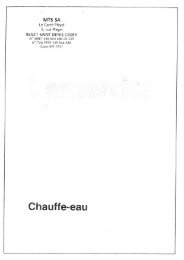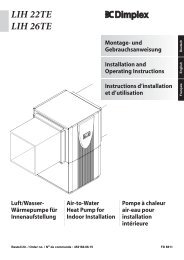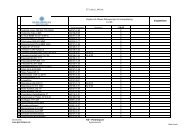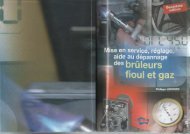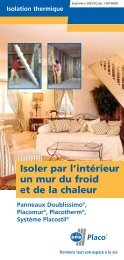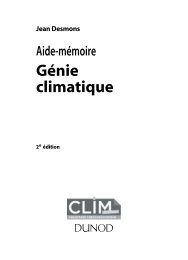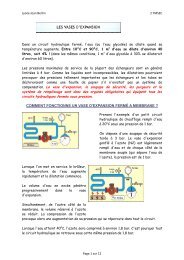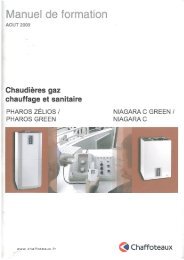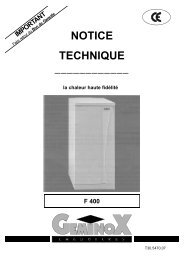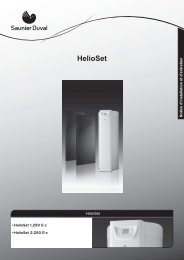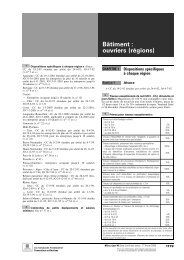MANUALE PER L'INSTALLAZIONE - enrdd.com
MANUALE PER L'INSTALLAZIONE - enrdd.com
MANUALE PER L'INSTALLAZIONE - enrdd.com
You also want an ePaper? Increase the reach of your titles
YUMPU automatically turns print PDFs into web optimized ePapers that Google loves.
2<br />
PIPING AND CONNECTIONS<br />
ATTENTION:<br />
- do not drink the condensation water (personal injury from poisoning)<br />
- Position the condensation drain pipe in such a way as to allow for the correct<br />
downflow of water in dedicated areas, and to prevent any inconvenience or<br />
damage to people, things, animals, plants and structures.<br />
- Use manual tools and equipment suitable for the intended use (in particular,<br />
make sure that the tool is not worn and that the handle is intact and fully fastened<br />
to the rest of the tool); use them correctly and make sure they don’t fall from<br />
a height. Put them safely back in place after use. (Personal injury from the falling<br />
splinters or fragments, inhalation of dust, shocks, cuts, pricks and abrasions).<br />
2.1 Connecting the refrigeration piping<br />
The piping can be positioned in 3 different directions as indicated with numbers<br />
1, 2 and 3 in the figure on the right. When the pipes are positioned in<br />
directions 1 or 3, the special groove designed on the side of the internal unit<br />
should be cut using a suitable tool. Turn the pipes in the direction of the hole<br />
in the wall, taking care not to constrict them in any way, and tape the copper<br />
piping, condensation drain pipe and electrical wiring together with electric<br />
(insulating) tape, keeping the condensation drain pipe at the bottom so that<br />
the water can flow freely.<br />
2.2 Draining the condensation from the internal unit<br />
The proper draining of condensation from the internal unit is fundamental<br />
for a good installation.<br />
1. Keep the condensation drain pipe at the bottom of the hole in the wall.<br />
2. Make sure the condensation drain pipe has a continuous gradient of<br />
approximately 3 cm per metre.<br />
3. Do not include any traps in the condensation discharge piping.<br />
4. Do not immerse the free end of the condensation drain pipe in water and<br />
do not leave it in the vicinity of places emanating unpleasant odours.<br />
5. When the installation is <strong>com</strong>plete, before turning on the appliance, make<br />
sure the condensation drain pipe works properly by pouring some water<br />
into the condensation drip water tray situated inside the internal unit.<br />
2.3 Draining the condensation from the external unit<br />
The condensation or water that forms in the external unit during operation in<br />
heating mode can be removed via the drain pipe fitting.<br />
Installation: fasten the drain pipe fitting to the 25 mm hole on the bottom of the<br />
unit, as illustrated in the diagram on the right.<br />
Connect the condensation drain pipe to the drain pipe fitting and ensure the<br />
other end of the pipe is ducted into a suitable drain.<br />
ATTENTION:<br />
-ONLY use copper pipes for ACR type air conditioning units or suitably insulated<br />
copper pipes.<br />
-Protect all connection cables and pipes in order to prevent their being<br />
damaged.<br />
-For R410A gas, use copper pipes with a suitable thickness<br />
- Never use pipes that have a thickness which is less than 0,8 mm.<br />
1<br />
In the figure<br />
below, for example,<br />
the piping is<br />
directed to the<br />
right.<br />
signal<br />
cable<br />
refrigeration<br />
piping<br />
power<br />
supply<br />
cable<br />
condensation<br />
drain pipe<br />
insulating sheath<br />
piping<br />
insulation<br />
refrigeration<br />
piping<br />
YES NO NO<br />
2<br />
3<br />
23



